Qualcomm Snapdragon S4 (Krait) Performance Preview - 1.5 GHz MSM8960 MDP and Adreno 225 Benchmarks
by Brian Klug & Anand Lal Shimpi on February 21, 2012 3:01 AM EST- Posted in
- Smartphones
- Snapdragon
- Qualcomm
- Adreno
- Krait
- Mobile
The MSM8960 is an unusual member of the Krait family in that it doesn't use an Adreno 3xx GPU. In order to get the SoC out quickly, Qualcomm paired the two Krait cores in the 8960 with a tried and true GPU design: the Adreno 225. Adreno 225 itself hasn't been used in any prior Qualcomm SoC, but it is very closely related to the Adreno 220 used in the Snapdragon S3 that we've seen in a number of recent handsets.
Compared to Adreno 220, 225 primarily adds support for Direct3D 9_3 (which includes features like multiple render targets). The resulting impact on die area is around 5% and required several months of work on Qualcomm's part.
From a compute standpoint however, Adreno 225 looks identical to Adreno 220. The big difference is thanks to the 8690's 28nm manufacturing process, Adreno 225 can now run at up to 400MHz compared to 266MHz in Adreno 220 designs. A 50% increase in GPU clock frequency combined with a doubling in memory bandwidth compared to Snapdragon S3 gives the Adreno 225 a sizable advantage over its predecessor.
| Mobile SoC GPU Comparison | |||||||||||
| Adreno 225 | PowerVR SGX 540 | PowerVR SGX 543 | PowerVR SGX 543MP2 | Mali-400 MP4 | GeForce ULP | Kal-El GeForce | |||||
| SIMD Name | - | USSE | USSE2 | USSE2 | Core | Core | Core | ||||
| # of SIMDs | 8 | 4 | 4 | 8 | 4 + 1 | 8 | 12 | ||||
| MADs per SIMD | 4 | 2 | 4 | 4 | 4 / 2 | 1 | 1 | ||||
| Total MADs | 32 | 8 | 16 | 32 | 18 | 8 | 12 | ||||
| GFLOPS @ 200MHz | 12.8 GFLOPS | 3.2 GFLOPS | 6.4 GFLOPS | 12.8 GFLOPS | 7.2 GFLOPS | 3.2 GFLOPS | 4.8 GFLOPS | ||||
| GFLOPS @ 300MHz | 19.2 GFLOPS | 4.8 GFLOPS | 9.6 GFLOPS | 19.2 GFLOPS | 10.8 GFLOPS | 4.8 GFLOPS | 7.2 GFLOPS | ||||
We turn to GLBenchmark and Basemark ES 2.0 V1 to measure the Adreno 225's performance:
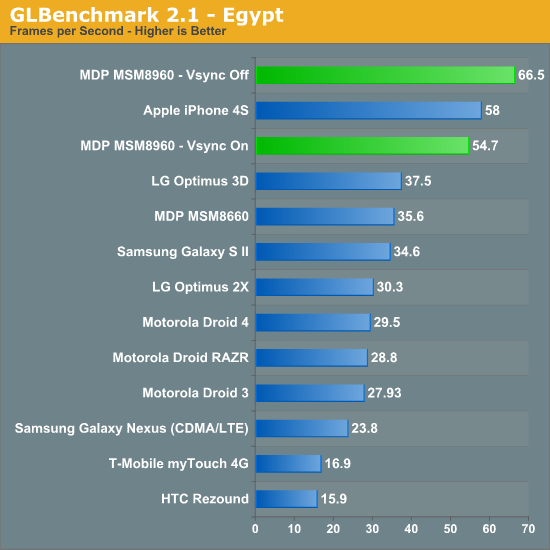
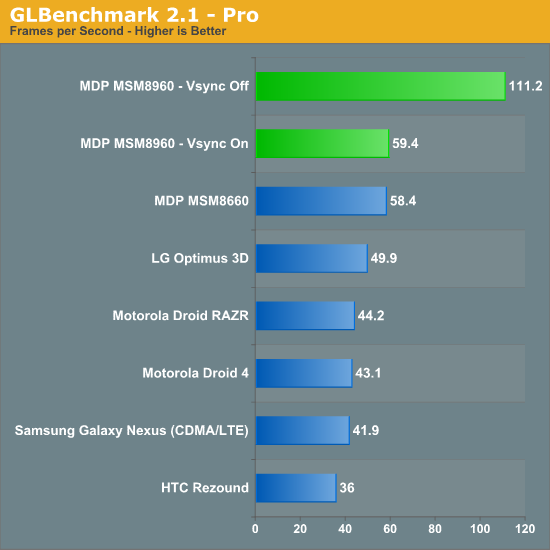
Limited by Vsync the Adreno 225 can actually deliver similar performance to the PowerVR SGX 543MP2 in Apple's A5. However if we drive up the resolution, avoid vsync entirely and look at 720p results the Adreno 225 falls short. Its performance is measurably better than anything else available on the Android side in the Egypt benchmark, however the older Pro test still shows the SGS2's Mali-400 implementation as quicker. The eventual move to Adreno 3xx GPUs will likely help address this gap.

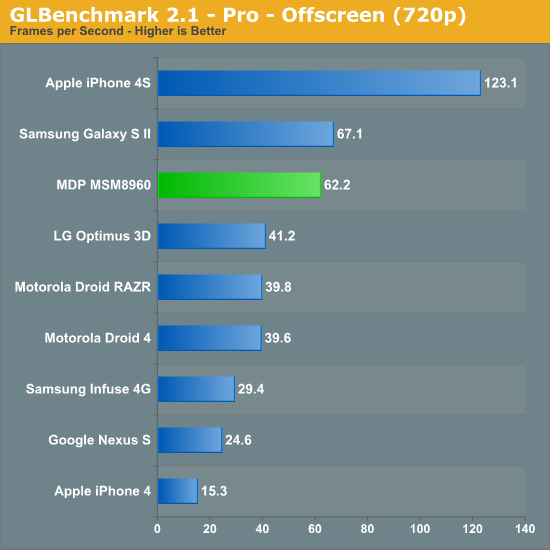
Basemark ES 2.0 tells a similar story (updated: notes below):
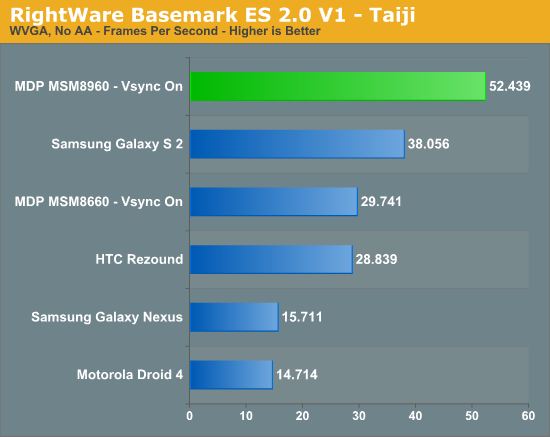
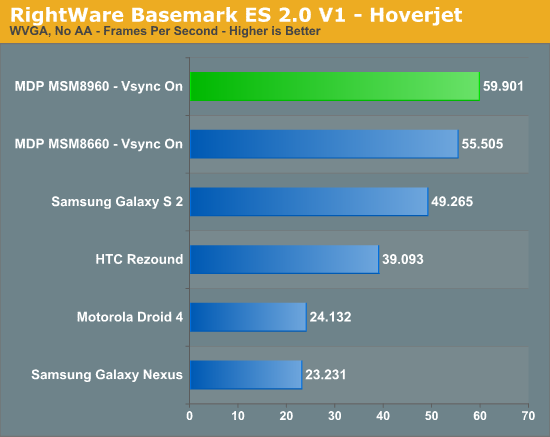
In the original version of this article we noticed some odd behavior on the part of the Mali-400 MP4 based Samsung Galaxy S 2. Initially we thought the ARM based GPU was simply faster than the Adreno 225 implementation in the MSM8960, however it turns out there was another factor at play. The original version of Basemark ES 2.0 V1 had anti-aliasing enabled and requested 4X MSAA from all devices that ran it. Some GPUs will run the test with AA disabled for various reasons (e.g. some don't technically support 4X MSAA), while others (Adreno family included) will run with it enabled. This resulted in the Adreno GPUs being unfairly penalized. We've since re-run all of the numbers with AA disabled and at WVGA (to avoid hitting vsync on many of the devices).
Basemark clearly favors Qualcomm's Adreno architecture, whether or not that's representative of real world workloads is another discussion entirely.
The results above are at 800 x 480. We're unable to force display resolution on the iOS version of Basemark so we've got a native resolution comparison below:
| RightWare Basemark ES 2.0 V1 Comparison (Native Resolution) | ||||
| Taiji | Hoverjet | |||
| Apple iPhone 4S (960 x 640) | 16.623 fps | 30.178 fps | ||
| Qualcomm MDP MSM8960 (1024 x 600) | 40.576 fps | 59.586 fps | ||
Even at its lower native resolution, Apple's iPhone 4S is unable to outperform the MSM8960 based MDP here. It's unclear why there's such a drastic reversal in standing between the Adreno 225 and PowerVR SGX 543MP2 compared to the GLBenchmark results. Needless to say, 3D performance can easily vary depending on the workload. We're still in dire need of good 3D game benchmarks on Android. Here's hoping that some cross platform iOS/Android game developers using Epic's UDK will expose frame rate counters/benchmarking tools in their games.










86 Comments
View All Comments
bhspencer - Tuesday, February 21, 2012 - link
Does anyone know if Linpak is using the hardware or software floating point calculations for the MFLOPS number.metafor - Wednesday, February 22, 2012 - link
Hardware. But it's run on the JIT instead of native code. According to CF-Bench, Java FP performance is around 1/3 of native. Neither actually use NEON but instead uses the older VFP instructions.vision33r - Tuesday, February 21, 2012 - link
The Tegra 3 is actually a big disappointment from a performance standpoint. It actually has 5 CPU cores and the GPU performance isn't much better than the Tegra 2. The Adreno 225 is a much bigger upgrade but I'm afraid that it's another marginal upgrade.The A5 in the iPad2/iPhone 4S are over 1 year old by March. In that time, Nvidia's Tegra 2/3 has not dominated and the MSM8960 is finally a true contender for the fastest SOC on the market. By the time this thing is out in volume, Apple has the A6 ready and most likely another 4-8x performance increase over the A5.
This SOC will probably be forgotten when the A6 is out.
LetsGo - Wednesday, February 22, 2012 - link
Yeah your right looking at my Asus Transformer Prime running GTA 3. /SA lot of graphical optimisations can be done on the CPU cores before data is offloaded to the GPU.
The moral of the story is that Benchmarks are only a rough guide at best.
tipoo - Wednesday, February 22, 2012 - link
Unless the rumors are true and its A5X, not A6, with just faster dual cores rather than quads on a newer architecture. I would not be surprised, its like the 3G-3GS was an architecture change, then the 4 was just a faster chip on a similar architecture. The iPad 2 was an architecture change, the 3 might just be a faster version of the same thing, hopefully with improvements in the GPU. I'd be fine with that, as long as the GPU kept up with the new resolution.Stormkroe - Tuesday, February 21, 2012 - link
I was just plotting out what little resolution scaling info there is here and noticed something very odd. Both the iphone 4s and galaxy s2 actually score MUCH higher when the resolution is raised to 720p offscreen. I can see that in the 4s' case it could be explained with fps caps, but the S2 is definitely not hitting a cap at 34.6 fps @ 800x480, yet it hits 42.5 fps @ 1280x720. All other phones predictably step down in speed. Anyone else notice this?Alexstarfire - Tuesday, February 21, 2012 - link
Yes I did. It was actually the reason I was going to post. I was curious to know if the iPhone had VSync or not because it made no sense that it would get better performance at a higher resolution. Neither of the results make any sense to me since they are counter-intuitive.If the "offscreen" tests force VSync off then that could explain it for the iPhone but not really for the SGSII unless some parts of the test go way past the 60FPS cap with VSync turned on.
alter.eg00 - Wednesday, February 22, 2012 - link
Shut up & take my moneyDenithor - Wednesday, February 22, 2012 - link
Seconded!!I'm still carrying a first generation HTC Incredible (yep, one of the original ones!), been out of contract for a few months, was waiting to hear more about the 28nm SoC update. These look really, really good, seriously looking forward to them hitting the market now!
tipoo - Wednesday, February 22, 2012 - link
I wonder how many apps scale beyond two cores. For the time being, I doubt its many, and since you're still not doing any true multitasking I think a faster dual core like this will trump a slower quad like the Tegra 3 most of the time.